Comptroller Kevin Lembo Archive > News
COMPTROLLER LEMBO PROJECTS $118.4-MILLION DEFICITPOINTS TO SLOW JOB GAINS IN FINANCIAL SERVICES SECTOR
In a letter to Gov. Dannel P. Malloy, Lembo said the Office of Policy and Management’s (OPM) latest projection is on target given several economic factors, and the outlook could change further after the nonpartisan consensus revenue forecast is released Nov. 10.
General Fund revenue projections for Fiscal Year 2016 have been revised downward by $117.4 million from last month. Lembo said the largest adjustment is to the income tax, which is reduced by $109.3 million this month, reflecting lower than anticipated receipts from the payroll withholding portion of the tax. This brings the total income tax reduction for the fiscal year to $195.7 million.
"Part of the slow wage growth can be attributed to the distribution of job gains by employment sector during this recovery,” Lembo said. "The financial services sector pays wages more than 50 percent above the statewide average for all sectors. However, the financial services sector remains 14,900 jobs (10.2 percent) below its pre-recession level.
"At the same time, the leisure and hospitality sector that pays wages 46 percent below the statewide average for all sectors has added 19,000 jobs (13.7 percent).
"Until the overall growth in the state employment numbers results in higher wage growth, which is consistent with an expanding economy, the withholding portion of the income tax will continue to present significant budget challenges.”
Lembo said that, in Fiscal Year 2005, as the economy continued to expand, the withholding portion of the income tax grew at a rate of 8.1 percent. Over the past three years, the growth in withholding has been below four percent.
"This has implications for this year - and future fiscal years,” Lembo said. "Current projections indicate that Fiscal Year 2016 will also post growth in the withholding component of the income tax below four percent. One factor constraining growth in the payroll-driven receipts is that Connecticut, like the nation, has experienced stagnant wage growth throughout the current recovery.
"There are also other risk factors on the horizon that could significantly alter the current projection.”
Lembo said, as OPM noted, that failure to conclude a successful federal budget agreement – an ongoing risk factor – would have a negative impact on the state budget in Fiscal Year 2016 and perhaps the out years as well.
"In addition, an increase in interest rates could reduce bond premiums that are built into the current budget,” Lembo said. "However this must be weighed against the fact that credit-rating firms are downgrading more U.S. companies than at any other time since the financial crisis, and measures of corporate debt relative to cash flow are rising. This may result in a continued premium on the type of high quality debt offered by Connecticut. There are numerous other economic impacts of higher interest rates that are not built into current budget projections.
"Finally, our state economy is linked to the national economy which, in turn, is dependent on the global economy. Global economic events have generally constrained domestic growth. China’s economy (second largest in the world) has been slowing. In response, its central bank cut interest rates in hopes of boosting growth. Less oil demand from China as the economy slowed has produced a sharp drop in oil prices as well as coal and other commodities. As a result of less demand, oil costs have nearly halved over the past year. The cheaper oil, while benefiting U.S. consumers and the domestic economy, has damaged oil -exporting economies that had been expanding, such as Brazil and Russia, in addition to many Middle Eastern producers. The European economy has also struggled to grow, advancing at an annual pace of less than 2 percent.”
Lembo pointed to some of the latest economic indicators from federal and state Departments of Labor and other sources that show:

• Through September, year-to-date income tax withholding receipts were
running 3.5 percent above the same period last year. Implementation of new tax
rate tables incorporating the higher rate structure as adopted in PA 15-244 was
required by the end of August. Therefore, the September 2015 receipts
incorporate the higher tax rates.
• Withholding receipts are the largest single source of state tax revenue,
accounting for 61 percent of the total income tax receipts in Fiscal Year 2015
and almost 40 percent of total General Fund tax receipts in that year. As can be
seen from the graph below, with the exception of the increases experienced in
Fiscal Years 2011 and 2012 that resulted from tax increases, withholding growth
has been well below normal post-recession levels.
• The FY 16 budget anticipated growth of 5.2 percent in the withholding
component of the income tax. In October, OPM revised that growth rate projection
to 3.2 percent and consequently lowered the income tax estimate for the current
fiscal year by $109.3 million.
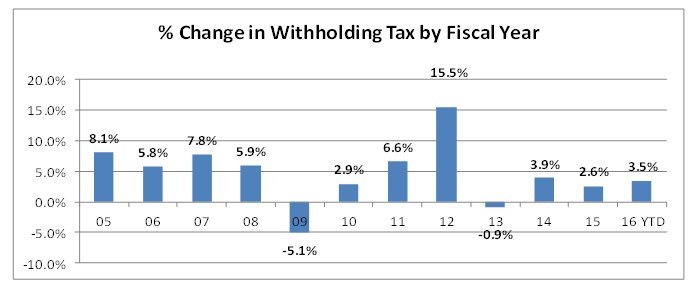
• According to the Department of Labor, preliminary September nonfarm
employment estimates from the U.S. Bureau of Labor Statistics (BLS) payroll
survey (seasonally adjusted) indicated that Connecticut lost 7,600 jobs in
September bringing payroll employment to a level of 1,693,500. This is the first
monthly state nonfarm jobs decline in five months. Connecticut is now estimated
to have added 27,000 nonfarm positions over the last 12 months, which is a
fairly typical gain during a period of economic expansion. August’s initially
estimated nonfarm job gain of 3,200 was revised upward to a gain of 5,400 jobs.
• Connecticut has now recovered 99,500 positions, or 83.6 percent of the 119,000
seasonally adjusted total nonfarm jobs that were lost in the state during the
March 2008 - February 2010 employment recession. Connecticut’s jobs recovery is
now 67 months old and is averaging about 1,485 jobs per month since February
2010. The private sector has recovered employment at a faster clip
(approximately 1,572 per month) and has now regained 105,300 (94.4 percent) of
the 111,600 private sector jobs that were lost during the same employment
downturn. The state needs to reach the 1,713,000 job level to enter a full
nonfarm employment expansionary phase. This will require an additional 19,500
nonfarm jobs. A total of 6,300 more private sector positions are needed to have
a fully restored private sector.
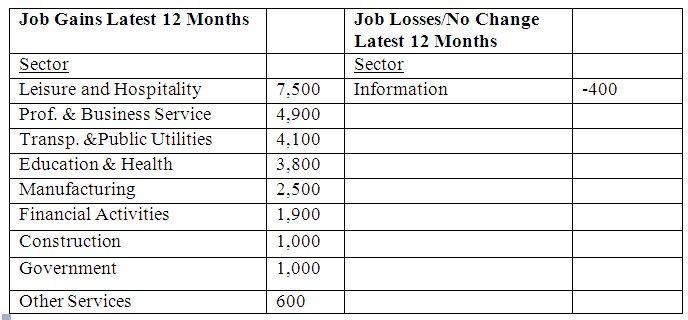
• U.S. employment has been advancing at a rate of 2 percent over the 12-month
period ending in September; Connecticut’s employment growth was 1.6 percent for
the same period.
• Connecticut’s unemployment rate was 5.2 percent in September; the national
unemployment rate was 5.1 percent. Connecticut’s unemployment rate has continued
to decline from a high of 9.5 percent in October 2010.
• There are 100,200 unemployed job seekers in Connecticut. A low of 36,500
unemployed workers was recorded in October of 2000. The number of unemployed
state workers hit a recessionary high of 177,200 in December of 2010.
• According to Georgetown University Center on Education and the Workforce,
about 23 percent of 18 to 34 year olds are underemployed nationally. This trend
is a factor in lackluster wage growth since the end of the recession.
![]()
• The Department of Labor reports that average hourly earnings at $29.57, not
seasonally adjusted, were up $1.31, or 4.6 percent, from the September 2014
estimate. The resulting average private sector weekly pay was figured at
$984.68, up $26.67, or 2.8 percent higher than a year ago. The differential
between the growth in hourly wages and weekly pay results from a reduction in
hours worked.
• The 12-month percent change in the Consumer Price Index for All Urban
Consumers (CPI-U, U.S. City Average, not seasonally adjusted) in September 2015
was 0.0% (unchanged).
• The graph below shows the monthly percent change from the prior year in
Connecticut weekly earnings. Connecticut and the nation as a whole have
struggled with stagnant wage growth. This graph provides monthly data through
September of 2015.
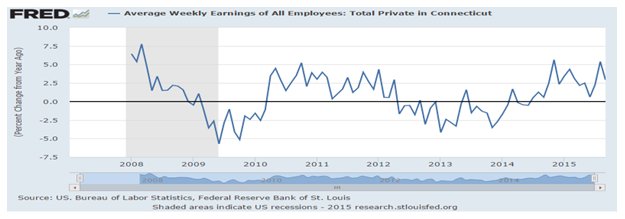
• One reason for the slow growth in statewide wages during this recovery has
been the distribution of job gains by sector.
• The financial services sector pays wages that are more than 50 percent above
the statewide average for all sectors. But the financial services sector remains
14,900 jobs (10.2 percent) below its pre-recession level. At the same time, the
leisure and hospitality sector that pays wages that are 46 percent below the
statewide average for all sectors has added 19,000 jobs (13.7 percent) to its
pre-recession level.
• The area between the two lines below illustrates the wage gap between the
financial sector that is still struggling recover from the recession, and the
leisure and hospitality sector that has far surpassed its pre-recession job
numbers.

• Slow wage growth has placed pressure on the state budget, and on the growth
of the larger economy. The downward adjustment to projected revenue in the
wage-driven portion of the state income tax, as discussed above, has resulted in
an Fiscal Year 2016 projected General Fund budget deficit.
• Based on 2nd quarter data from the Bureau of Economic Analysis released on
Sept. 30, Connecticut ranks 14th nationally in income growth. The chart below
shows the annual trend in Connecticut personal income over time.
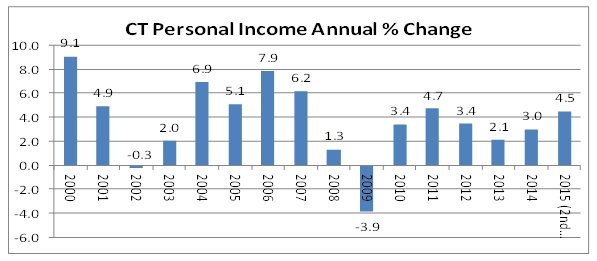

• According to an October report from the Warren Group, Connecticut single
family home sales increased 20.2 percent in August from the prior year. Home
prices in the state dropped for the fifth consecutive month. The median home
price in August was $255,000, a 5.5-percent drop from the $269,900 that homes
were going for in August 2014. Condominium sales followed a similar pattern with
strong sales volume and falling prices.
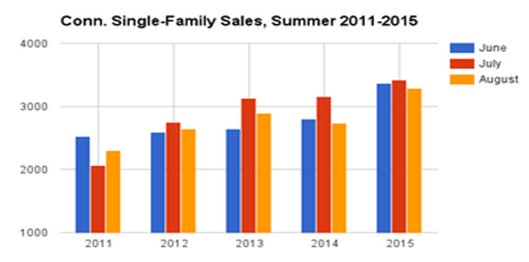
• Nationally, sales of existing homes rose 4.7 percent in September to the second-highest pace in eight years, as continued low interest rates and pent-up demand supported the housing recovery. Existing-home sales account for about 90 percent of the residential real-estate market.
Consumers
• Overall U.S. retail sales barely rose in September as cheaper gasoline
reduced service station receipts. But excluding gasoline, retail sales increased
at a respectable 0.4 percent last month.
• In September, receipts at service stations fell 3.2 percent, the largest drop
since January, after falling 2 percent in August. However, sales at auto
dealerships increased 1.7 percent after rising 0.4 percent in August. Clothing
store sales rose 0.9 percent in September. Sales at furniture stores rose 0.6
percent. Receipts at sporting goods and hobby stores increased 0.9 percent and
sales at restaurants and bars rose 0.7 percent. Sales at electronics and
appliance stores slipped 0.2 percent. Sales at online stores fell 0.2 percent.
Building materials and garden equipment stores were also off, declining 0.3
percent. Analysts note that the overall numbers point to solid domestic demand.
• Despite positive domestic sales numbers, economic growth has softened in
recent months, mainly because of weak exports, declining capital spending in the
energy sector due to lower oil prices and inventory corrections, which have
slowed manufacturing activity.
• The Conference Board's consumer confidence index fell to 97.6 in October, down
from a nine-month high of 102.6 in September. The decline likely reflects the
results of two consecutive jobs reports. Employers added just 142,000 jobs in
September and 136,000 jobs in August, after routinely chalking up monthly net
jobs gains in excess of 200,000.
• According to the Federal Reserve, consumer credit increased by $16.0 billion
in August ($12-billion rise in non-revolving credit and a $4-billion rise in
revolving credit). Total credit grew at a 5.6 percent seasonally adjusted annual
rate in August. That increase was slower than the 6.6 percent revised rate
posted in July. Revolving credit rose 5.3 percent in August, while non-revolving
credit rose 5.7 percent, both slower than their July rates. Non-revolving credit
growth (car and student loans) has been the steady contributor to overall credit
growth, having posted a gain in every month since August 2011. Revolving credit
(credit card) growth has been more volatile, steadily climbing but occasionally
falling back. The gain in August was the sixth in a row.
Business and Economic Growth
• According to the Oct. 29 release by the Bureau of Economic Analysis, based
on the advance estimate, GDP increased at an annual rate of 1.5 percent in the
third quarter of 2015. In the second quarter, real GDP increased 3.9 percent.
• Global economic events have constrained domestic growth. China’s economy
(second largest in the world) has been slowing. In response, its central bank
cut interest rates in hopes of boosting growth. Less oil demand from China as
the economy slowed has produced the sharp drop in oil prices as well as coal and
other commodities.
• As a result of less demand, oil costs have nearly halved to roughly $44 a
barrel over the past year. The cheaper oil has damaged oil exporting economies
such as Brazil and Russia, in addition to many Middle Eastern producers. The
European economy has struggled to grow at all, advancing at an annual pace of
less than 2 percent.
• Corporate profits grew by less than 1 percent in the second quarter of 2015
compared to the same quarter last year. Growth in corporate profits did not
exceed 2 percent in 2013 or 2014.
Stock Market
• Estimated and final income tax payments account for approximately 40
percent of total state income tax receipts. These payments show a correlation to
activity in equity markets relating to capital gains.
• Estimated income tax receipts increased 5.3 percent in Fiscal Year 2015
compared to the prior fiscal year. The first significant month of estimated
payment receipts for Fiscal Year 2016 is September. Through September estimated
payments were accelerating at a 6.5-percent rate over the same period last
fiscal year. Typically, final payments exceed estimated payments. The bulk of
final payments are received in April, so trend analysis at this point is not
especially revealing.
• Over the past several years, the state has experienced significant
fluctuations in capital gains related receipts. In late 2012, investors turned
over a large volume of long-term capital gains to take advantage of the expiring
15-percent tax rate, which increased to a top long-term rate of 23.8 percent (20
percent rate plus 3.8 percent on AGI above $200,000 related to the ACA) on Jan.
1, 2013. As a result, the state realized a windfall on the capital gains driven
portion of the income tax in Fiscal Year 2013. Because this left little in
unrealized gains, this component of the income tax experienced a sharp drop in
Fiscal Year 2014. As the market surged, investors were reluctant to take
short-term gains because such gains are taxed at the higher ordinary income
rate.
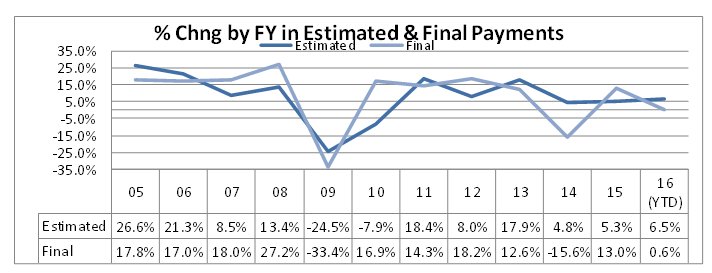
• It is difficult to assess the impact that the current market correction
cycle will have on state revenue given the behavior changes that investors have
made in the face of federal tax changes.
• December/January estimated payment activity will provide additional data to
assess the impact of market activity on state receipts.
• It is notable that trading volume has been generally declining over the past
decade as can be seen on the bar graph on the chart below. This lower volume
provides less opportunity for dramatic swings in gains and losses. The market
correction to date is far less dramatic than the 2008-2009 collapse. More
recently, trading volume has typically been highest at lower market levels.
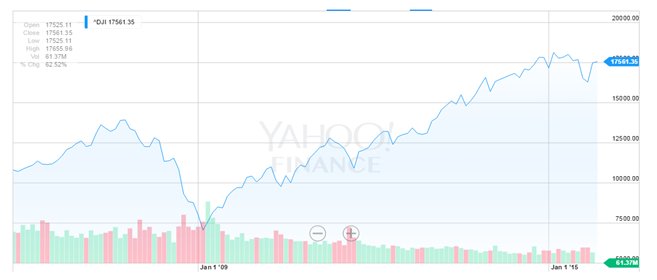
***END***
